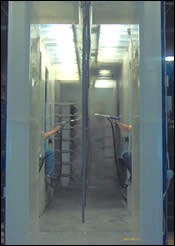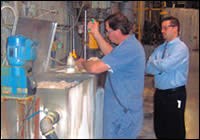Small-Scale Thinking
Nano-technology pretreatment improves powder coating quality and productivity.
In the past couple of years, managers at the Flexcel plant in Post Falls, ID, have completely re-invented the finishing process for their products.
The company first replaced its liquid paint application process with powder coating, completing the transition near the end of 2004. The result, according to first-shift Manufacturing Manager Garrett Brown, was a substantial increase in product quality. “The switch from paint to powder boosted quality yield from approximately 93% to 98%,” he recalls.
The plant manufactures metal office furniture, panel systems and file storage products for its parent company Kimball International (Jasper, IN) as well as for other office furniture OEMs. The facility is divided into three main sections—metal fabrication, finishing and assembly. Work materials are mainly cold-rolled steel and aluminum extrusions.
Post Falls operates in a make-to-order environment using lean manufacturing principles and techniques. The plant runs three finishing lines: a batch line for fast-turnaround, short run jobs; a mid-size line and a large main line with more than a mile of conveyor. Cycles on the three lines, from the time parts are hung on hooks until they are removed after cooling, are one, two, and three hours, respectively. Throughput on the main line is 2,000–2,200 carriers a day. The other lines process another 100–200 carriers daily working two shifts.
The nature of the plant’s business–building custom furniture a variety of customers–results in an average of about 65 color changes a day on the powder line, says Process Engineer David Mills. “With that many color changes, we don’t reclaim powder,” he explains. “Our transfer efficiency runs between 40 and 60%.”
Environmental Issues
You might think figuring out what to do with that waste powder would be a problem, but it isn’t, says Plant Environmental Manager Terry Hentges. “They use the powder to help power the waste-to-energy facility in Spokane (WA),” he explains. “It burns really well, and they’ll take all of it we give them.”
Hentges adds that doing away with liquid paint processes substantially reduced the plant’s environmental footprint by cutting volatile organic compound (VOC) emissions by approximately 200,000 lb/yr. The plant also switched from a water-based glue process to double-sided tape for panel assembly operations, resulting in less landfill waste from this process and a safer work environment for employees.
Those changes left the plant’s iron phosphate powder pretreatment process as Hentges’ biggest headache. “Only 650 ft of pipeline separate the plant from the nearest wastewater treatment plant,” he explains. “If we would have a discharge of, for example, hot water, it would impact their operations. And, most treatment plants aren’t set up to handle phosphates.” Even worse, he says, the state of Washington is considering a new threshold on phosphates that would essentially reduce allowable discharges to zero. (Post Falls is on the Spokane River near the Washington/Idaho border, about 20 miles east of Spokane, and the only wastewater treatment facility between Flexcel and the Columbia River 40 miles away is the one near the plant.)
But environmental concerns weren’t the only reason managers began taking a hard look at the plant’s pretreatment process. Quality and energy cost issues also impacted their decision-making process.
“Our previous pretreatment system consisted of a cleaning stage with a mild surfactant, then the iron phosphate stage, then two rinse stages, then a rinse with deionized water,” Mills recalls. “With the new process, we use an alkaline cleaner, rinse, then the new nano-ceramic conversion coating, then a fresh water rinse. We don’t have to use DI to meet performance requirements.”
The new conversion coating is Bonderite NT-1, a reactive nano-ceramic process that is free of phosphate, regulated heavy metals and organic components. The nanometer-scale deposit produced by the process is more cost-effective than conventional iron phosphating, and provides corrosion resistance equal to or better than an iron phosphate/polymer seal, according to developer Henkel Corporation (Madison Heights, MI).
Henkel says the pretreatment is suitable for all conventional powder and wet paint coatings, can be applied by immersion or spraying and creates an inorganic, extremely high-density layer incorporating nano-particles. It results in a conversion layer on the order of nanometers thick, as opposed to phosphate, which is on the order of microns
thick.
The process coats steel, aluminum and zinc-coated substrates, and is said to deliver better corrosion protection and paint adhesion than iron phosphating. It runs at ambient temperature and eliminates a passivation step, further decreasing costs. Its low-sludge characteristics reduce waste disposal, cleaning and maintenance.
Making The Switch
According to Mills, the transition to the new pretreatment process required some modifications to the plant’s existing equipment. "We needed a stainless steel tank to hold the NT-1, which is acidic,” he says. “The main issue involved the tanks on our mid-size monorail line. They’re mild steel, so we had to line them. But our other tanks were stainless steel, so we didn’t have to do anything with them.” Some pump parts also required modification, he adds.
Post Falls managers proved out the new process on their mid-size finishing line before rolling it out on their large system. “The conversion was one of the smoothest I’ve seen,” Mills recalls. “We did a lot of testing, and then we did the conversion over a weekend.
“We also had to test parts to prove they met our salt spray, humidity chamber and other requirements,” he continues. “We had to get approvals from the city, from the state and from Kimball corporate environmental. So we basically proved out the new pretreatment on our smaller monorail system. It handles less than 10% of our volume, so it was a good test platform.”
Multiple Benefits
The pretreatment worked as advertised at Post Falls, providing operating and environmental benefits that resulted in a quick return on investment.
“Energy savings was a key,” Mills says. “The old process had cleaning and phosphate stages heated to about 140°F. Now, we’ve eliminated process heating. We’re saving close to $50,000 a year in gas costs.
“Our process is also more consistent and easier to control, and we were able to standardize our mid-size and large lines with one chemistry. Before, we had different chemical makeups on each of three systems,” he adds.
In terms of part quality, the switch virtually eliminated water spots and adhesion failures, according to Mills. He attributes the quality improvements to use of a more aggressive alkaline cleaner, which provides better surface quality than the mild surfactant used previously.
Environmentally, the process produces much less sludge than the previous pretreatment. “We still pump out our tanks once a year, but we don’t have to have a tanker truck to haul away the sludge as hazardous waste,” Brown explains. “Now all we have to do is neutralize the pH.”
Related Content
How to Address Declining Powder Coating Coverage Over Time
Fine particles from reclaim could be to blame for powder coating problems that emerge over time. Avoid problems by keeping hooks clean, maintaining guns and using reclaim powder quickly to avoid accumulation of fines.
Read MoreTTX’s Automated Conveyor Carrier System Offers Wireless, Flexible Operation
ACC system designed for reliable, consistent point-to-point movement of everything from small to heavy parts.
Read MoreReduced, Reused and Recycled Powder Coatings Are the Future
They say necessity is the mother of invention, and with millions of pounds of powder coating going into landfills a year, these two companies have found novel approaches to dealing with this waste stream.
Read MoreSelecting the Right Outdoor-Durable Powder Coating
The powder coating industry offers an array of chemistries to provide an excellent match to the manufacturer’s expectations for outdoor durability.
Read MoreRead Next
Episode 45: An Interview with Chandler Mancuso, MacDermid Envio Solutions
Chandler Mancuso, technical director with MacDermid Envio discusses updating your wastewater treatment system and implementing materials recycling solutions to increase efficiencies, control costs and reduce environmental impact.
Read MoreDelivering Increased Benefits to Greenhouse Films
Baystar's Borstar technology is helping customers deliver better, more reliable production methods to greenhouse agriculture.
Read MoreEducation Bringing Cleaning to Machining
Debuting new speakers and cleaning technology content during this half-day workshop co-located with IMTS 2024.
Read More











.jpg;maxWidth=300;quality=90)












